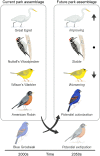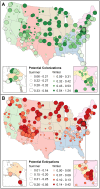Projected avifaunal responses to climate change across the U.S. National Park System
- PMID: 29561837
- PMCID: PMC5862404
- DOI: 10.1371/journal.pone.0190557
Projected avifaunal responses to climate change across the U.S. National Park System
Abstract
Birds in U.S. national parks find strong protection from many longstanding and pervasive threats, but remain highly exposed to effects of ongoing climate change. To understand how climate change is likely to alter bird communities in parks, we used species distribution models relating North American Breeding Bird Survey (summer) and Audubon Christmas Bird Count (winter) observations to climate data from the early 2000s and projected to 2041-2070 (hereafter, mid-century) under high and low greenhouse gas concentration trajectories, RCP8.5 and RCP2.6. We analyzed climate suitability projections over time for 513 species across 274 national parks, classifying them as improving, worsening, stable, potential colonization, and potential extirpation. U.S. national parks are projected to become increasingly important for birds in the coming decades as potential colonizations exceed extirpations in 62-100% of parks, with an average ratio of potential colonizations to extirpations of 4.1 in winter and 1.4 in summer under RCP8.5. Average species turnover is 23% in both summer and winter under RCP8.5. Species turnover (Bray-Curtis) and potential colonization and extirpation rates are positively correlated with latitude in the contiguous 48 states. Parks in the Midwest and Northeast are expected to see particularly high rates of change. All patterns are more extreme under RCP8.5 than under RCP2.6. Based on the ratio of potential colonization and extirpation, parks were classified into overall trend groups associated with specific climate-informed conservation strategies. Substantial change to bird and ecological communities is anticipated in coming decades, and current thinking suggests managing towards a forward-looking concept of ecological integrity that accepts change and novel ecological conditions, rather than focusing management goals exclusively on maintaining or restoring a static set of historical conditions.
Conflict of interest statement
Figures





References
-
- U.S. Congress. The National Park Service Organic Act. National Park Service, 39 Stat. 535, 16 U.S.C. Sect. 1–4 1916.
-
- Wade AA, Hand BK, Kovach RP, Muhlfeld CC, Waples RS, Luikart G. Assessments of species’ vulnerability to climate change: from pseudo to science. Biodivers Conserv. 2016; 1–7.
-
- Monahan WB, Fisichelli NA. Climate exposure of US national parks in a new era of change. PLoS ONE. 2014;9: e101302 doi: 10.1371/journal.pone.0101302 - DOI - PMC - PubMed
-
- Fisichelli NA, Schuurman GW, Hoffman CH. Is ‘resilience’ maladaptive? Towards an accurate lexicon for climate change adaptation. Environ Manage. 2016;57: 753–758. doi: 10.1007/s00267-015-0650-6 - DOI - PMC - PubMed
-
- Langdon JG, Lawler JJ. Assessing the impacts of projected climate change on biodiversity in the protected areas of western North America. Ecosphere. 2015;6: art87.
Publication types
MeSH terms
LinkOut - more resources
Full Text Sources
Other Literature Sources
Medical

